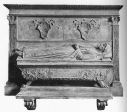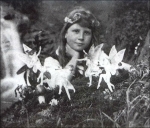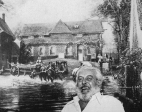The Met's Fake Etruscans: 1915-1960

Fake Etruscan Warrior
|
Between 1915 and 1921 the New York Metropolitan Museum of Art acquired three large terra-cotta statues of Etruscan warriors. They were valued parts of its collections until 1960 when it was discovered that they were fakes. Apparently the black glaze with which they were covered contained manganese, which was not used as a dye during ancient times. One of the forgers, Alfredo Fioravanti, was found to still be alive. Fioravanti proved that he had created the statues when he produced a thumb that was missing from one of them.
Alceo Dossena: 1878-1937

Sculptured tomb attributed to Mino da Fiesole, actually by Dossena
|
One of the greatest forgers of all times, Dossena was a stonemason who lived in Northern Italy. In 1916 he began producing statues carved to resemble ancient sculptures, and these were widely sold by dealers. Dossena was so good at his craft, that dealers began marketing his statues as actual antiquities. Dossena himself blew the whistle on this practice when he realized that the dealers were selling his pieces for far more than they were paying him. Many of his pieces continue to circulate throughout the art world as genuine antiquities.
The Cottingley Fairies: 1917

Frances Griffiths with fairies
|
In 1917 two young girls, Frances Griffiths and her cousin Elsie Wright, took a famous series photographs outside of their home in Cottingley, Yorkshire. The pictures showed themselves apparently surrounded by flying fairy creatures. The photos were seized upon and celebrated by members of Britain's spiritualist movement as evidence of the existence of fairies. Sir Arthur Conan Doyle, author of the Sherlock Holmes mysteries, especially championed the authenticity of the pictures. It was not until 1983 that the two cousins confessed that the fairies in the pictures were simply paper cutouts held in place with hatpins.
The Disumbrationist School of Art: 1924-1928

'Exaltation'
|
In 1924 Paul Jordan Smith, an LA-based novelist and latin scholar, painted a picture of a South Seas islander holding a banana over her head. The picture was intended to be a spoof of the abstract style of modern schools of art such as cubism. As a joke he entered it into an art exhibition, claiming that it was a work by Pavel Jerdanowitch (a name he had invented) who was the founder of the Disumbrationist School of art (another invention of his). He titled the work 'Exaltation' and explained that it represented the shattering of the bonds of womanhood, because the woman had just taken a bite of a banana and was waving the banana skin over her head in triumphant freedom. The work was praised, and Smith eventually painted and exhibited more pictures in the Disumbrationist style. The hoax ended when Smith finally tired of the deception and revealed the true identity of Pavel Jerdanowitch to the Los Angeles Times.
Joseph Cosey: 1887-1950(?)
Joseph Cosey was famous for his ability to forge the handwriting of the great figures of American history: Ben Franklin, Abraham Lincoln, Thomas Jefferson, etc. He was born Martin Coneely in 1887. After a career as a small-time thief, he began forging documents from American history in 1929. His forgeries were so good that they could fool most experts. In fact, he prided himself on never selling his forgeries to amateur collectors. One of his most famous forgeries was a draft of the Declaration of Independence supposedly written in Jefferson's handwriting.
Hans van Meegeren: 1889-1947

'Christ and the Adulteress'
|
In 1947 Hans van Meegeren, a Dutch artist and art dealer, was arrested for collaborating with the Nazis. It was charged that he had sold a painting by Johannes Vermeer (1632-75) titled 'Christ and the Adulteress' to Reich Marshal Hermann Goering. This painting was considered a national treasure, making it a crime to sell it to the enemy. Van Meegeren defended himself by revealing that the painting was a forgery which he had painted himself. It turned out that he had forged many paintings in the style of the great masters and made a great deal of money for himself in doing so. He was convicted of forgery and sentenced to prison, but died of a heart attack before he served any time.
Twenty One, TV Quiz Show: 1956-1957

Van Doren on Twenty One
|
During the 1950s Twenty One was one of the most popular quiz shows on TV. Its ratings soared when Charles Van Doren, son of Pulitzer Prize-winning poet Mark Van Doren, appeared as a contestant on it in late 1956. Van Doren seemed unbeatable. For week after week he answered every question correctly, winning a total of $129,000. But in 1957 a previous contestant, Herbert Stempel, revealed that the entire show was rigged. Van Doren, it turned out, was being fed the correct answers. A congressional investigation followed, and NBC, the producer of the show, issued an embarrassed confession.
Tom Keating: 1917-1984

Tom Keating with one of his paintings
|
Keating was one of the most prolific art forgers of the 20th Century. During the course of his career, he forged over 2000 paintings by more than 100 different artists. He grew up in cockney London, began to restore paintings for a living after World War II, and soon turned to forgery. He confessed to his activities in 1976, but the criminal charges brought against him were eventually dropped. He then starred in a television program about his artistic techniques. He died on February 12, 1984.
The Three Modis: 1984

Students posing with their fake Modi
|
The artist Amadeo Modigliani (1884-1920) grew up in Livorno, Italy. As a young man, he left Livorno for Paris. Legend had it that upon leaving he threw a number of his sculptures into a local canal. In 1984, in honor of Modigliani's 100th birthday, the city council of Livorno decided to dredge the canal to see what they would find. To their surprise, three sculpted heads turned up, which they dubbed Modi 1, Modi 2, and Modi 3. These were hailed as a significant discovery by art critics, until it was learned that all three were fakes. Three university students had carved one of them and thrown it into the canal. As proof, they produced a videotape of themselves carving the head and posing with it. A local dockworker had created the other two.
Milli Vanilli: 1988-1990

Milli Vanilli accepting a Grammy award
|
In 1988 Robert Pilatus and Fabrice Morvan, two young men from Munich, were formed into a pop group known as Milli Vanilli by German producer Frank Farian. They quickly became one of the most popular groups of the late 1980s, propelled to stardom on the strength of their single "Girl You Know It's True." However, unbeknownst to their fans, Pilatus and Morvan were lip-synching all their songs. The real vocals were performed by professional studio musicians. In 1990, when Pilatus and Morvan demanded that they be allowed to sing on their next album, Farian instead called a press conference and exposed the act as a sham. The duo tried to record an album on their own, under the name Rob and Fab, but their effort failed miserably. In 1998 Pilatus was found dead in a hotel room due to a drug overdose. He was 32 years old.
|








